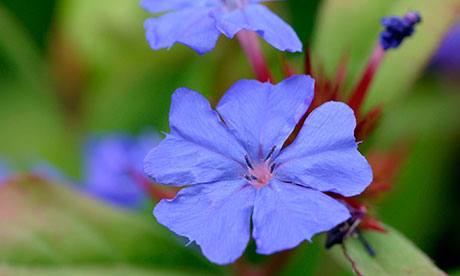
Singing the blues: the inky flowers of Ceratostigma willmottianum. Photograph: Alamy
It is a wonderful interlude when the season tips from summer into autumn, leaving behind the need to keep everything prim and proper. A well-planned garden will have plenty that is now at its best, for a host of plants have spent the summer preparing for just this moment: aster, black-eyed Susan and Joe-Pye weed soar head and shoulders above us, with rioting nasturtiums ascending where they have got away and autumn crocuses breaking their summer dormancy.
The term "well-planned" might engender fear, gloom or indeed a smile, but good planning is no different from putting together a meal. You need complementary ingredients, with contrasts and a sequence of events from start to finish. Pacing a planting is the greater part of understanding how to combine plants, and though I might initially think about a mood or a colour scheme when I am planning, it is ensuring that there is continuing seasonal interest that ultimately makes a planting scheme earn its keep.
Right now we are spoilt for choice, with a palette of autumn-fruiting shrubs and trees waiting to colour up. Hip-bearing roses and euonymus, rowans, hawthorns and ink-berried elders are a fine backdrop and will provide some structure. Underneath their limbs you might plant spring bulbs and early summer perennials, but out in the open you need to leave yourself room for a range of perennials to cover the several months of the growing season.
Think about how plants appear in a meadow: cowslips first, buttercups rising above them, moon daisies next with the ascending grasses and finally wild carrots, scabious and knapweeds – one covering for the next. Planning a perennial planting benefits from much the same approach: aim to create a knit of companions so that in any one space you might find plants for at least three seasons.
Many late-flowering perennials are lofty and will sail above their neighbours to cover for them once they are finished. You need to leave them enough room to build up strength over the summer, and pairing them with perennials that come up early but are happy to sink into their shade once the others ascend will see you through the summer. Take, for instance, a combination of early geraniums and peonies, interplanted with asters to rise above them after they are over and you're halfway there. Add bulbs for spring and a sprinkling of annual "Fairy Wings" poppies to seek out the gaps.
To ensure that you have good cover for this late in the season, you should reserve up to a third of your space for late perennials and their allies. It might seem like space taken from the summer garden, but the wait will be worth it. A hot spot among early nepeta and stachys might give rise to late-flowering Ceratostigma willmottianum, with its inky-blue flowers and red in the foliage. Add some Amaryllis belladonna in a really warm spot and you will gain the company of "Naked Ladies" that rise up out of nowhere.
Rudbeckias are not backward in coming forward and will wash the late summer garden with colour. I use mid-sized Rudbeckia fulgida deamii, with dark cones that last well into winter, the delicate R subtomentosa and R laciniata "Herbstsonne". I love this rangy plant where there is room – and you will need it, as it towers above head height. To soften the blow of the rudbeckias, team them with late-flowering grasses to throw a bronzed veil over the daisies. Molinia caerulea "Windspiel", Panicum strictum or Miscanthus nepalensis will take this long to look their best but will be worth the wait. They will have remained smart the summer long, waiting for their fast and furious early companions to come and go.
You will forget the bulbs that lie in wait at their feet ready to reappear in six months' time, and the perfume of the Valeriana officinalis that made its home among their stems in early summer, and be happy that you planned for the finale.
Get growing
Simple combinations make the best ones. Choose two or three plants that like the same conditions and you are more than half way to striking the right balance.